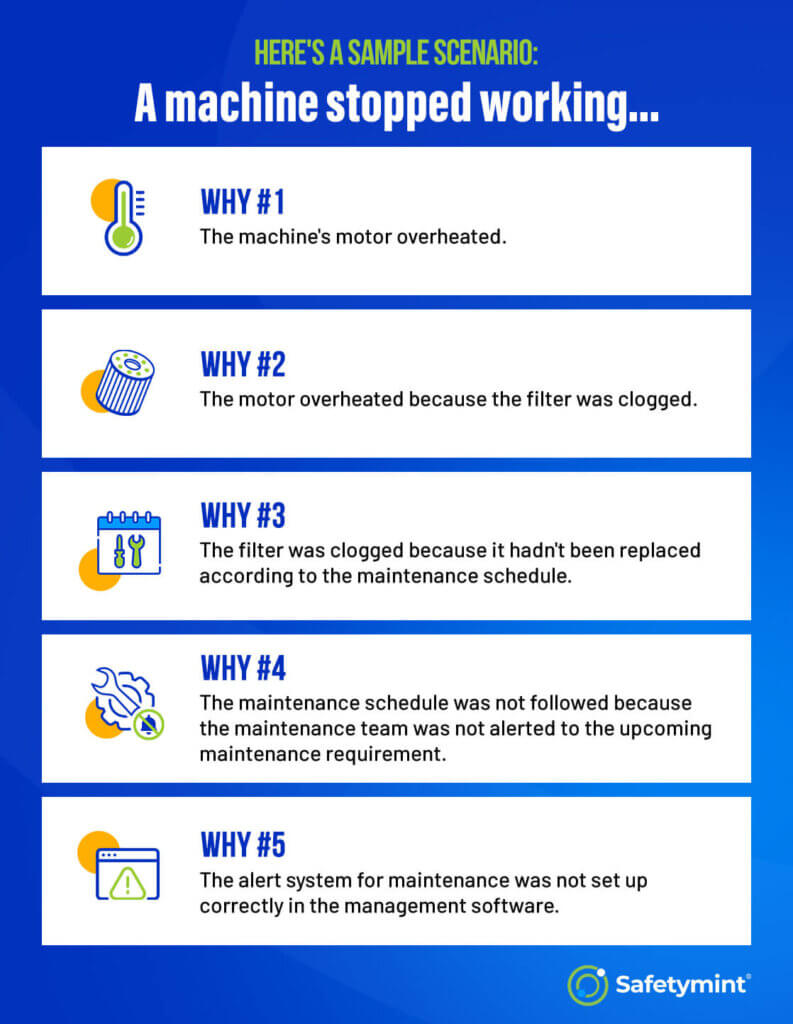
Why-Why Analysis (5-Whys) – Benefits and Examples
Introduction to Why-Why Analysis
Ever found yourself tangled in a problem, feeling like you’re chasing your tail trying to solve it? That’s where Why-Why Analysis, or as it’s affectionately known, the 5-Whys, comes into play. It’s like having a conversation with a problem until it reveals its deepest secrets. Simple, right? Let’s dive in.
Imagine you’re a detective in the world of incidents and observations. Your mission: to get to the bottom of problems without getting lost in the maze of symptoms. Why-Why Analysis is your trusty sidekick in this mission. Originating from the brilliant minds at Toyota, this technique has traveled far and wide, proving its mettle across industries. It’s not just about asking “Why?” five times; it’s about peeling away the layers of an issue until the root cause stands bare.
Why dive into Why-Why Analysis?
Here’s the scoop:
- It’s straightforward: No fancy tools or degrees required. Just your team, a problem, and a relentless pursuit of the truth.
- It fosters teamwork: Picture this—your team, gathered around, bouncing ideas and insights. It’s collaborative problem-solving at its best.
- It leads to real solutions: By understanding the root cause, you’re not just putting a band-aid on the problem; you’re fixing it for good.
So, ready to turn problems into opportunities with a dash of curiosity and a sprinkle of teamwork? Let’s get the conversation started with Why-Why Analysis.
How to Conduct a Why-Why Analysis:
Alright, let’s roll up our sleeves and get down to business. Conducting a Why-Why Analysis is like embarking on a treasure hunt. You know there’s gold (a.k.a. the root cause) out there; you just need to follow the map. Here’s how you and your team can navigate through:
1. Spot the X on the Map: Start with a clear problem statement. It’s your ‘X marks the spot’. Without it, you’re just wandering the high seas.
2. Assemble Your Crew: Gather a team with diverse knowledge. More perspectives mean a richer journey.
3. Embark on the Quest: Ask “Why?” and let the first answer guide you deeper. Each “Why?” is a step closer to the treasure.
4. Dig Deeper: Don’t settle for surface-level answers. Be like a curious child who’s never satisfied until the real reason is uncovered.
5. Find the Treasure: Once you’ve hit the root cause, you’ll know. It feels like finding the final piece of a puzzle.
Here’s a real-life scenario for you: Imagine a safety incident occurred because a machine stopped suddenly. Asking “Why?” leads from a simple operational hiccup to uncovering a systemic issue in maintenance routines. Voilà! You’ve not only identified the problem but also paved the way for lasting solutions.

Benefits of Why-Why Analysis:
Embarking on a Why-Why Analysis adventure isn’t just for the thrill. The treasures you uncover along the way are valuable gems for any organization. Here’s what you stand to gain:
- Simplicity Is Key: No need for a compass or a map; this method relies on the power of straightforward questioning.
- Team Spirit: Imagine your team, united by curiosity, navigating through challenges together. It’s team building and problem-solving all rolled into one.
- Lasting Solutions: Finding the root cause means you can address the issue once and for all. No more recurring nightmares.
Integrating Why-Why Analysis with Incident Management:
Now, let’s bridge the old with the new. Integrating Why-Why Analysis into your incident and observation management, especially with a tool like Safetymint, is like having a GPS for your treasure hunt. Here’s the magic it brings:
- Streamlined Process: Log incidents, conduct your analysis, and track actions all in one place. Efficiency at its finest.
- Data-Driven Decisions: Use the insights gathered to prevent future incidents. It’s like having a crystal ball that actually works.
- Enhanced Collaboration: Share findings and actions with your team seamlessly. Keep everyone in the loop and foster a culture of safety.
Best Practices and Common Pitfalls:
Even the best explorers can hit a storm. Here are some navigational aids to keep your Why-Why Analysis voyage smooth:
- Keep an Open Mind: Avoid jumping to conclusions. The sea of problems is full of surprises.
- Avoid the Blame Game: Focus on the issue, not the people. Remember, we’re hunting for solutions, not witches.
- Ensure Follow-Through: Discovering the root cause is only part of the journey. Implementing the solution is what treasures are for.
And beware of the pitfalls:
- Stopping Too Soon: Don’t settle for the first ‘why’. The real treasure is often buried deeper.
- Overlooking the Obvious: Sometimes, the treasure is right under your nose. Don’t ignore simple solutions in search of complex ones.
Ben Johnson is a dedicated Customer Success Executive at Safetymint. With a strong commitment to excellence, Ben works closely with customers to ensure they fully leverage the capabilities of Safetymint to its fullest potential, aiming to significantly reduce or mitigate safety risks and incidents.



